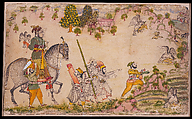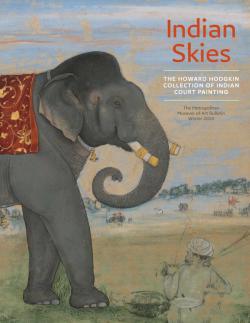Sangram Singh Hawking
Attributed to The Stipple Master Indian
The artist known as the Stipple Master of Udaipur was active under the patronage of Amar Singh II (r. 1698–1710) and continued working into the reign of Sangram Singh (r. 1710–34), likely the subject of the painting at top. The narrative depicts the maharaja’s bird of prey at four separate moments, as if captured in a series of still photographs. A subdued palette applied with stippling (most evident in the treatment of the horse) evokes the European grisaille technique introduced via Mughal art.The painting below—a visual celebration of an expedition undertaken by Amar Singh II himself—is one of the earliest Rajput paintings devoted to hawking. The maharaja, mounted on his chestnut stallion, raises his gloved hand to support the bird of prey, which is already unhooded and awaiting the order to strike. Three of his huntsmen (shikaris) point toward the nesting and circling flock of sarus cranes. The hawk is next seen in the upper landscape and then the third, where it attacks a crane and brings it down in the lake.
Due to rights restrictions, this image cannot be enlarged, viewed at full screen, or downloaded.


